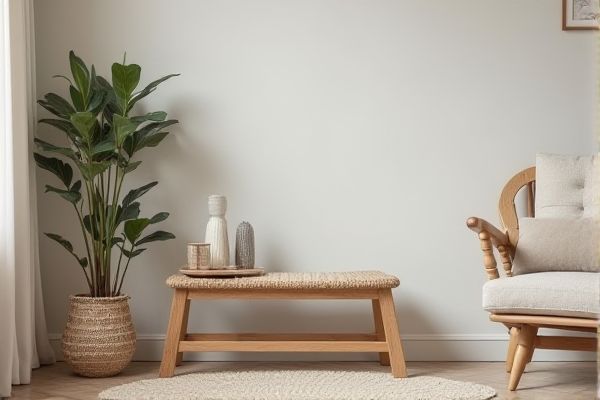
A footstool is designed primarily for resting your feet comfortably, often found in living rooms or offices, while a step stool is built for climbing to reach higher places, offering stability and height support. Explore the full article to understand which option best suits your needs and space.
Table of Comparison
| Feature | Footstool | Step Stool |
|---|---|---|
| Primary Use | Elevate feet for comfort | Reach higher objects safely |
| Height | Typically 6-12 inches | Typically 12-24 inches or higher |
| Design | Low, cushioned or solid surface | Sturdy steps, flat platforms |
| Material | Wood, foam, fabric | Wood, metal, plastic |
| Weight Capacity | Not designed for standing | Supports full body weight |
| Portability | Lightweight, easy to move | May be foldable for storage |
| Common Locations | Living room, office | Kitchen, garage, workshops |
Introduction to Footstools and Step Stools
Footstools are low pieces of furniture designed primarily for resting feet and enhancing comfort while seated. Step stools serve a practical purpose by providing a stable platform to reach higher places in homes or workplaces. Both items vary in design, height, and functionality, catering to different user needs for convenience and support.
Key Differences Between Footstools and Step Stools
Footstools primarily provide a comfortable elevation for your feet while sitting, offering ergonomic support and relaxation. Step stools are designed for stability and height, enabling You to safely reach higher shelves or perform tasks that require a boost. Key differences include their size, weight capacity, and intended use, with footstools focusing on comfort and step stools on functionality and safety.
Common Uses for Footstools
Footstools are commonly used to provide comfortable support for your feet while sitting, enhancing relaxation and promoting better posture. They are often placed in living rooms or offices to offer ergonomic benefits, reducing leg fatigue during extended periods of sitting. Unlike step stools, footstools prioritize comfort rather than elevation for reaching higher places.
Typical Applications for Step Stools
Step stools are commonly used in kitchens and bathrooms to reach high shelves, cabinets, and storage spaces safely. They are essential in retail environments and warehouses for accessing elevated inventory and performing maintenance tasks. Their sturdy design supports varied weight capacities, making them suitable for both residential and commercial applications.
Materials and Design Comparison
Footstools are often crafted from wood, fabric, or leather, prioritizing comfort and aesthetics for living spaces, while step stools typically use metal or durable plastic for strength and safety in reaching higher places. Footstool designs emphasize cushioned tops and decorative elements, contrasting with step stools that feature non-slip surfaces and sturdy steps for practicality. Your choice depends on whether you need a functional climbing aid or a comfortable resting foot support.
Safety Considerations: Footstool vs Step Stool
Footstools generally have lower height and a wider base, offering stable support for resting your feet but limited safety for climbing. Step stools are designed with safety features such as non-slip surfaces, sturdy steps, and handrails to securely support your weight when reaching higher places. Prioritize your safety by choosing a step stool with proper slip resistance and weight capacity for tasks requiring elevation.
Comfort and Ergonomics Analysis
Footstools provide superior comfort by allowing your feet to rest at a natural angle, reducing pressure on the lower back and promoting better posture. Step stools, designed primarily for reaching higher places, prioritize height and stability over comfort, often lacking ergonomic support for prolonged use. Choosing a footstool enhances ergonomic benefits by supporting leg elevation and minimizing strain during seated activities.
Space and Storage Requirements
Footstools typically have a compact design that fits easily under furniture, requiring minimal storage space, while step stools often have larger, bulkier frames to support climbing, demanding more room. Your choice depends on available storage areas; footstools are ideal for tight spaces, whereas step stools may need dedicated storage spots due to their size and weight. Optimizing space and storage efficiency is crucial when selecting between a footstool and a step stool.
Choosing the Right Stool for Your Needs
Choosing the right stool depends on your specific tasks: a footstool is designed to provide comfort and support for resting your feet, enhancing posture and relaxation, while a step stool offers stability and height to safely reach elevated areas. Consider the stool's weight capacity, height, and portability based on where and how you plan to use it. Your decision should balance functionality and safety to ensure the stool meets your daily requirements effectively.
Conclusion: Footstool or Step Stool?
Choosing between a footstool and a step stool depends on the intended use: a footstool is designed primarily for comfort and relaxation, providing support for resting feet, while a step stool is built for functionality, helping users reach higher places safely. Footstools tend to be lower, cushioned, and aesthetically focused, making them ideal for living rooms or offices, whereas step stools are sturdier, often made of wood or metal, tailored for tasks requiring height elevation. For practical tasks and safety in reaching elevated areas, a step stool is the optimal choice; for ergonomic comfort and added decor, a footstool serves best.
 homyna.com
homyna.com